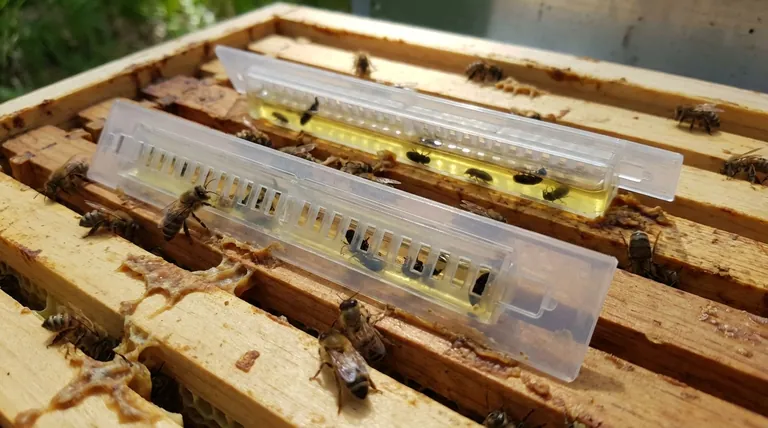At its core, a Beetle Blaster is a simple mechanical trap. It uses a two-part system that exploits the natural hiding behavior of the Small Hive Beetle (SHB). A specially designed top allows beetles to enter a lethal reservoir of oil below, while the trap's dimensions are specifically engineered to prevent bees from getting in.
The Beetle Blaster's effectiveness hinges on a simple deception: it offers beetles what appears to be a safe, dark crevice to hide, which is actually a one-way entrance into a container of oil.

The Core Mechanism: A Two-Part System
The trap's design is deceptively simple but highly effective, relying on two key components working in unison.
The Selective-Entry Top
The top of the Beetle Blaster is typically made of black plastic. This color helps it blend in and mimics the dark crevices that Small Hive Beetles naturally seek out.
It features very thin slots, precisely sized to allow adult beetles to crawl through. These slots are too narrow for honey bees to enter, ensuring the trap is selective and safe for the colony.
The Lethal Reservoir
The bottom of the trap is a clear plastic basin that you partially fill with a liquid agent. This is what makes the trap lethal to the beetles.
Beekeepers commonly use vegetable or mineral oil. Once beetles enter the trap to hide, they fall into the oil. The oil coats their bodies, preventing them from climbing out or flying, and they ultimately drown.
Exploiting Beetle Behavior
The trap doesn't rely on chemical attractants or bait. Instead, it capitalizes on the innate instincts of the Small Hive Beetle and the defensive actions of the bees.
The Instinct to Hide
Small Hive Beetles are an invasive pest, and honey bees recognize them as a threat. Bees will actively chase beetles, trying to harass them or imprison them in propolis.
This chase forces the beetles to constantly seek out small, dark spaces within the hive where the bees cannot reach them.
A Deceptive Safe Haven
The Beetle Blaster is designed to look like an ideal hiding spot. When a beetle is fleeing from bees, it sees the dark, slotted entrance of the trap and enters, believing it has found refuge.
The bees' own hygienic behavior of chasing pests directly contributes to the trap's success by driving the beetles into it.
Understanding the Trade-offs and Best Practices
While effective, the success of Beetle Blasters depends entirely on proper implementation.
Placement is Critical
These traps are designed to be placed between the top bar of the frames in your hive boxes. The ideal location is between the outer frames, where beetles often congregate.
Incorrect placement, such as on the bottom board, will render the trap almost completely ineffective.
Choosing the Right Agent
While various oils work, using a food-grade vegetable or mineral oil is the safest choice for your hive. This prevents any contamination of honey if a spill were to occur.
Never use harsh chemicals or pesticides in the trap, as this could harm or kill your bees.
Regular Maintenance is Required
The traps must be checked and emptied periodically. A trap full of dead beetles will no longer be effective.
Additionally, bees may try to seal the slots with propolis over time. You should inspect the traps and clear any blockages to ensure beetles can still enter.
Making the Right Choice for Your Goal
To use Beetle Blasters effectively, align your strategy with your primary objective for hive health.
- If your primary focus is maximizing beetle capture: Place traps in the upper-most hive body between frames 1-2 and 9-10, and check them weekly to empty and refill as needed.
- If your primary focus is hive safety and simplicity: Use a food-grade vegetable oil and handle the traps carefully during inspections to avoid spilling any oil onto the bees or comb.
- If you are dealing with a severe infestation: Remember that traps are a control method, not a cure. They should be used as part of an integrated pest management strategy that may include other control measures.
Ultimately, the Beetle Blaster provides beekeepers with a simple, non-chemical tool to help protect their colonies from a persistent pest.
Summary Table:
| Key Component | Function | Benefit |
|---|---|---|
| Selective-Entry Top | Black plastic with thin slots allows beetles in, keeps bees out. | Protects the honey bee colony from harm. |
| Lethal Reservoir | Basin filled with oil (e.g., vegetable oil) drowns beetles. | Provides a non-chemical, effective kill method. |
| Behavioral Exploitation | Mimics a dark hiding spot, exploiting beetles' instinct to flee bees. | Lures beetles naturally without bait or attractants. |
Protect Your Apiary with Professional-Grade Equipment
Struggling with Small Hive Beetle infestations? As a trusted wholesale supplier to commercial apiaries and beekeeping equipment distributors, HONESTBEE provides the durable, effective tools you need for integrated pest management.
We supply reliable solutions like Beetle Blasters to help you safeguard your colonies and your investment. Let's discuss how our range of beekeeping supplies can support your operation's health and productivity.
Contact HONESTBEE today for wholesale pricing and expert support.
Visual Guide

Related Products
- Removable Washable Hive Beetle Trap Attractants for Small Hive Beetles
- Plastic Beetle Blaster Trap Beekeeping Tools and Supplies
- Reusable Clear Small Hive Beetle Traps for Beehives Beetle Trapping Tools
- Reusable Aluminium Beetle Trap for Small Hive Beetles Silver Bullet
- Black Plastic Beetle Barn Hive Beetle Trap for Beehives
People Also Ask
- What are the chemical-free options for trapping hive beetles? Control Pests Without Chemicals
- What is the recommended number of beetle traps per hive? Optimize Your Hive's Beetle Defense
- How do hive beetle traps work? A Beekeeper's Guide to Non-Chemical Control
- What are small hive beetles and where are they not indigenous? Protect Your Apiary from This Invasive Pest
- What are the steps for installing hive beetle traps? A Guide to Effective Beetle Control



















